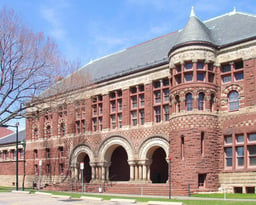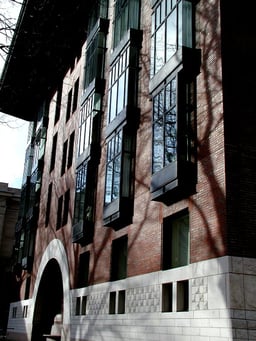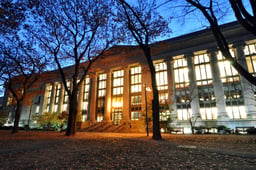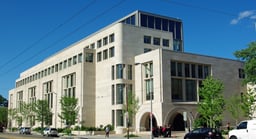Harvard Law School
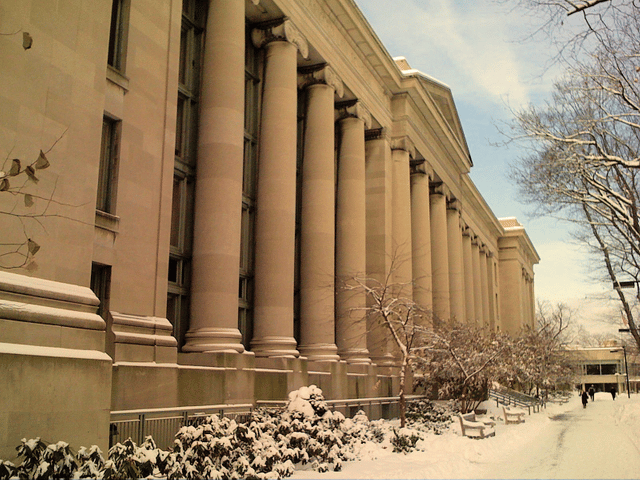
Harvard Law School

| Harvard Law School | |
|---|---|
| Motto | Veritas[1] |
| Parent school | Harvard University |
| Established | 1817 |
| School type | Law school, Private |
| Dean | John F. Manning |
| Location | Cambridge, Massachusetts, United States |
| Enrollment | 1,990 |
| Faculty | 100–150 |
| USNWR ranking | 3rd (2018)[2] |
| Website | hls.harvard.edu [68] |
 | |
Harvard Law School is one of the professional graduate schools of Harvard University located in Cambridge, Massachusetts. Founded in 1817, it is the oldest continuously operating law school in the United States and one of the most prestigious in the world.[3][4] It is ranked first in the world by the QS World University Rankings and the ARWU Shanghai Ranking.[5][6]
Each class in the three-year J.D. program has approximately 560 students, among the largest of the top 150 ranked law schools in the United States.[7] The first-year class is broken into seven sections of approximately 80 students, who take most first-year classes together. Harvard's uniquely large class size and prestige have led the law school to graduate a great many distinguished alumni in the judiciary, government, and the business world.
According to Harvard Law's 2015 ABA-required disclosures, 95% of the Class of 2014 passed the Bar exam.[8] Harvard Law School graduates have accounted for 568 judicial clerkships in the past three years, including one-quarter of all Supreme Court clerkships,[9] more than any other law school in the United States.
Harvard Law School's founding is traditionally linked to the funding of Harvard's first professorship in law, paid for from a bequest from the estate of Isaac Royall, Jr., a colonial American landowner and a slaveholder. Today, it is home to the largest academic law library in the world.[10][11] The law school has 328 faculty members.[12]
| Harvard Law School | |
|---|---|
| Motto | Veritas[1] |
| Parent school | Harvard University |
| Established | 1817 |
| School type | Law school, Private |
| Dean | John F. Manning |
| Location | Cambridge, Massachusetts, United States |
| Enrollment | 1,990 |
| Faculty | 100–150 |
| USNWR ranking | 3rd (2018)[2] |
| Website | hls.harvard.edu [68] |
 | |
History
Bequest by Isaac Royall and founding

Portrait of Isaac Royall, painted in 1769 by John Singleton Copley
Harvard Law School's founding is traced to the establishment of a "law department" at Harvard in 1817.[13] Dating the founding to the year of the creation of the law department makes Harvard Law the oldest continuously-operating law school in the nation. William & Mary Law School opened first in 1779, but closed due to the American Civil War, reopening in 1920.[14] The University of Maryland School of Law was chartered in 1816, but did not begin classes until 1824, and also closed during the Civil War.[15]
The founding of the law department came two years after the establishment of Harvard's first endowed professorship in law, funded by a bequest from the estate of wealthy slaveowner Isaac Royall, Jr., in 1817.[13] Royall left roughly 1,000 acres of land in Massachusetts to Harvard when he died in exile in Nova Scotia, where he fled as a British loyalist during the American Revolution, in 1781, "to be appropriated towards the endowing a Professor of Laws ... or a Professor of Physick and Anatomy, whichever the said overseers and Corporation [of the college] shall judge to be best."[16] The value of the land, when fully liquidated in 1809, was $2,938; the Harvard Corporation allocated $400 from the income generated by those funds to create the Royall Professorship of Law in 1815.[16] The Royalls were so involved in the slave trade, that "the labor of slaves underwrote the teaching of law in Cambridge."[17] The dean of the law school traditionally held the Royall chair, deans Elena Kagan and Martha Minow declined the Royall chair due to its origins in the proceeds of slavery. Nevertheless, Royall’s legacy at Harvard is lasting, Harvard Law School adopted the Royall family crest as apart of its school crest. That crest features as blue background, with three bushels of wheat. Until recently the connection of the seal to the slave owning Royalls was unknown to many. According to The Harvard Crimson "Most Law School alumni and faculty were unaware of the story behind the seal." In response to its ties to slavery, Harvard Law School decided to stop using the Royalls seal. It has yet to design a replacement seal.[18]
Royall's Medford estate, the Isaac Royall House, is now a museum which features the only remaining slave quarters in the northeast United States.
The Royall family coat-of-arms, which shows three stacked wheat sheaves, was adopted as the school crest in 1936, topped with the university motto (Veritas, Latin "truth").[19] In March 2016, following requests by students, the school decided to remove the emblem because of its association with slavery.[20]
Growth and the Langdell curriculum
By 1827, the school, with one faculty member, was struggling. Nathan Dane, a prominent alumnus of the college, then endowed the Dane Professorship of Law, insisting that it be given to then Supreme Court Justice Joseph Story. For a while, the school was called "Dane Law School."[21] In 1829, John H. Ashmun, son of Eli Porter Ashmun and brother of George Ashmun, accepted a professorship and closed his Northampton Law School, with many of his students following him to Harvard.[22] Story's belief in the need for an elite law school based on merit and dedicated to public service helped build the school's reputation at the time, although the contours of these beliefs have not been consistent throughout its history. Enrollment remained low through the 19th century as university legal education was considered to be of little added benefit to apprenticeships in legal practice. After first trying lowered admissions standards, in 1848 HLS eliminated admissions requirements entirely.[23] In 1869, HLS also eliminated examination requirements.[23]
In the 1870s, under Dean Christopher Columbus Langdell, HLS introduced what has become the standard first-year curriculum for American law schools – including classes in contracts, property, torts, criminal law, and civil procedure. At Harvard, Langdell also developed the case method of teaching law, now the dominant pedagogical model at U.S. law schools. Langdell's notion that law could be studied as a "science" gave university legal education a reason for being distinct from vocational preparation. Critics at first defended the old lecture method because it was faster and cheaper and made fewer demands on faculty and students. Advocates said the case method had a sounder theoretical basis in scientific research and the inductive method. Langdell's graduates became leading professors at other law schools where they introduced the case method. The method was facilitated by casebooks. From its founding in 1900, the Association of American Law Schools promoted the case method in law schools that sought accreditation.[24][25]
20th century: institutional criticism
During the 20th century Harvard Law School was known for its competitiveness. For example, Robert C. Berring, Jr. called it "a samurai ring where you can test your swordsmanship against the swordsmanship of the strongest intellectual warriors from around the nation."[26] When Langdell developed the original law school curriculum, Harvard President Charles Eliot told him to make it "hard and long."[27][28] An urban legend holds that incoming students are told to "Look to your left, look to your right, because one of you won't be here by the end of the year."[29] Scott Turow's memoir One L and John Jay Osborn's novel The Paper Chase describe such an environment.
In addition, Eleanor Kerlow's book Poisoned Ivy: How Egos, Ideology, and Power Politics Almost Ruined Harvard Law School criticized the school for a 1980s political dispute between newer and older faculty members over accusations of insensitivity to minority and feminist issues. Divisiveness over such issues as political correctness lent the school the title "Beirut on the Charles."[30]
In Broken Contract: A Memoir of Harvard Law School, Richard Kahlenberg criticized the school for driving students away from public interest and toward work in high-paying law firms. Kahlenberg's criticisms are supported by Granfield and Koenig's study, which found that "students [are directed] toward service in the most prestigious law firms, both because they learn that such positions are their destiny and because the recruitment network that results from collective eminence makes these jobs extremely easy to obtain."[31] The school has also been criticized for its large first year class sizes (at one point there were 140 students per classroom; in 2001 there were 80), a cold and aloof administration,[32] and an inaccessible faculty. The latter stereotype is a central plot element of The Paper Chase and appears in Legally Blonde.
In response to the above criticisms, HLS eventually implemented the once-criticized[28] but now dominant approach pioneered by Dean Robert Hutchins at Yale Law School, of shifting the competitiveness to the admissions process while making law school itself a more cooperative experience. Robert Granfield and Thomas Koenig's 1992 study of Harvard Law students that appeared in The Sociological Quarterly found that students "learn to cooperate with rather than compete against classmates," and that contrary to "less eminent" law schools, students "learn that professional success is available for all who attend, and that therefore, only neurotic 'gunners' try to outdo peers."[31]
21st century

Elena Kagan
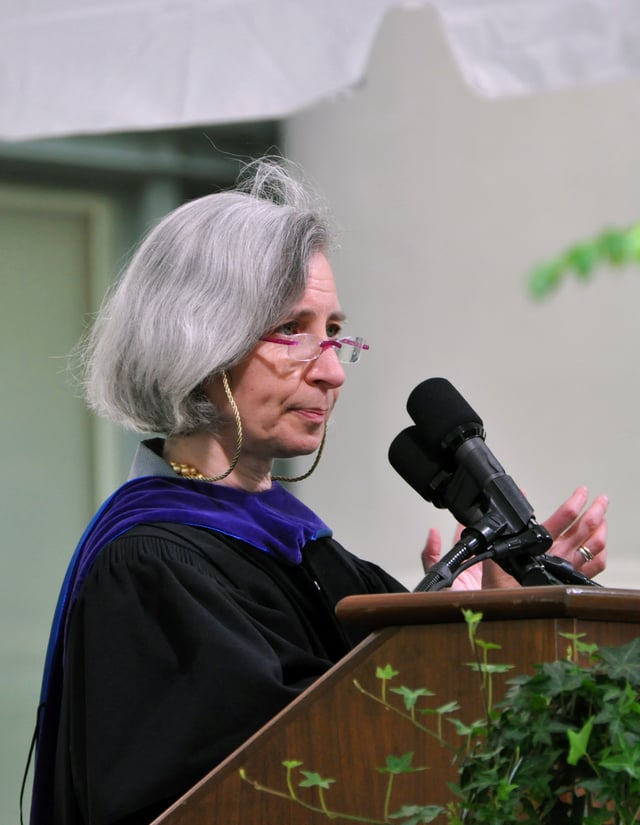
Martha Minow
Under Kagan, the second half of the 2000s saw significant academic changes since the implementation of the Langdell curriculum. In 2006, the faculty voted unanimously to approve a new first-year curriculum, placing greater emphasis on problem-solving, administrative law, and international law. The new curriculum was implemented in stages over the next several years,[33][34] with the last new course, a first year practice-oriented problem solving workshop, being instituted in January 2010. In late 2008, the faculty decided that the school should move to an Honors/Pass/Low Pass (H/P/LP) grading system, much like those in place at Yale and Stanford Law Schools. The system applied to half the courses taken by students in the Class of 2010 and fully started with the Class of 2011.[35]
In 2009, Kagan was appointed solicitor general of the United States by President Barack Obama and resigned the deanship. On June 11, 2009, Harvard University president, Drew Gilpin Faust named Martha Minow as the new dean. She assumed the position on July 1, 2009. On January 3, 2017, Minow announced that she would conclude her tenure as dean at the end of the academic year.[36] In June 2017, John F. Manning was named as the new dean, effective as of July 1, 2017.[37]
In September 2017, the school unveiled a plaque acknowledging the indirect role played by slavery in its history:
In honor of the enslaved whose labor created wealth that made possible the founding of Harvard Law School May we pursue the highest ideals of law and justice in their memory[38]
Reputation
Employment
More than 120 from the last five graduating classes have obtained tenure-track law teaching positions.[41] Adjusted for student body size, this puts Harvard in second place among U.S. law schools, about 2 percentage points ahead of Stanford and Chicago (which tied for third place) but behind Yale.
According to the Employment Summary for 2014 Graduates, 90% were employed in bar passage required jobs and another 4.4% were employed in J.D. advantage jobs.[42]
| |||||||||||||||||||||||||||||||||||||||||||||||||||||||||||||||||
Costs
The total cost of attendance (indicating the cost of tuition, fees, and living expenses) at Harvard Law for the 2017–2018 academic year is $92,200.[44]
Shield retirement
In 2016, the governing body of the university, the Harvard Corporation, voted to retire the law school's 80 year old arms. The arms, depicting three garbs (the heraldic term for wheat sheaves), was based in part upon the coat of arms of Isaac Royall Jr., a university benefactor who had endowed the first professorship in the law school. The shield had become a source of contention among a group of law school students, who objected to the Royall family's history as slave-owners.[45][46]
The president of the university and dean of the law school, acting upon the recommendation of a committee formed to study the issue, ultimately agreed with its majority decision,[47] that the shield was inconsistent with the values of both the university and the law school. Their recommendation was ultimately adopted by the Harvard Corporation and on March 15, 2016, the shield was ordered retired.[48][49][50]
Student organizations and journals
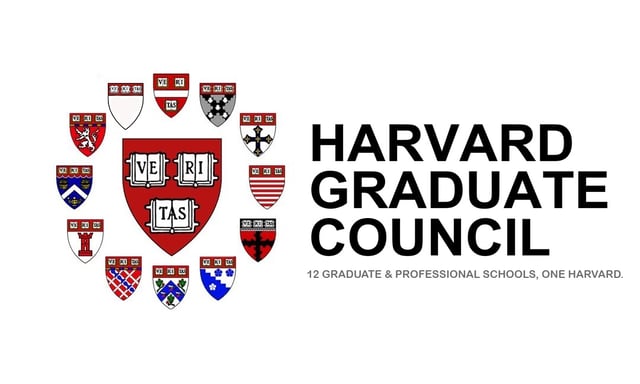
Law School participates in the Harvard Graduate Council (HGC), a University-wide student government
Harvard Law School has more than 90 student organizations that are active on campus.[51] These organizations include the student-edited journals, Harvard Law Record, and the HLS Drama Society, which organizes the annual Harvard Law School Parody, the Harvard Legal Aid Bureau as well as other political, social, service, and athletic groups. HLS Student Government is the primary governing, advocacy, and representative body for Law School students. In addition, students are represented at the university level by the Harvard Graduate Council.
Harvard Law Review
Students of the Juris Doctor (JD) program are involved in preparing and publishing the Harvard Law Review, one of the most highly cited university law reviews, as well as a number of other law journals and an independent student newspaper. The Harvard Law Review was first published in 1887 and has been staffed and edited by some of the school's most notable alumni.[52] In addition to the journal, the Harvard Law Review Association also publishes The Bluebook: A Uniform System of Citation, the most widely followed authority for legal citation formats in the United States. The student newspaper, the Harvard Law Record, has been published continuously since the 1940s, making it one of the oldest law school newspapers in the country, and has included the exploits of fictional law student Fenno for decades.[53][54] The Harvard Law School Forum on Corporate Governance and Financial Regulation, formerly known as the Harvard Law School Corporate Governance Blog, is one of the most widely read law websites in the country.
Harvard Law School student journals
Harvard Law Review
Harvard Business Law Review[55]
Harvard Civil Rights-Civil Liberties Law Review
Harvard BlackLetter Law Journal[56]
Harvard Environmental Law Review
Harvard Human Rights Journal
Harvard International Law Journal
Harvard Journal of Law & Gender (formerly Women's Law Journal)
Harvard Journal of Law & Public Policy
Harvard Journal of Law and Technology
Harvard Journal of Sports and Entertainment Law
Harvard Journal on Legislation
Harvard Latino Law Review
Harvard Law & Policy Review
Harvard National Security Journal
Harvard Negotiation Law Review
Unbound: Harvard Journal of the Legal Left
Harvard Business Law Review
Notable people
Alumni
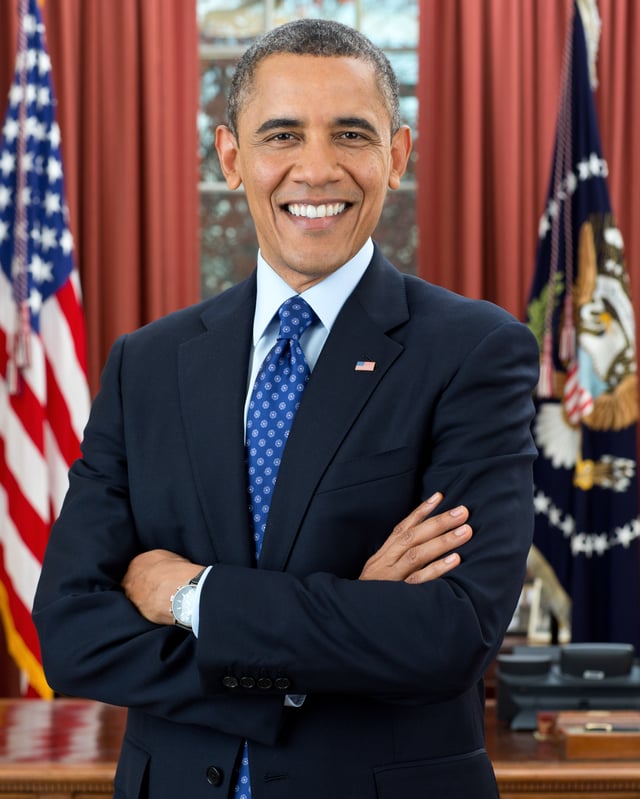
Barack Obama

Andrew Cheung, Permanent Judge of the Court of Final Appeal of Hong Kong; 4th chief judge of the High Court of Hong Kong (2011-2018 )
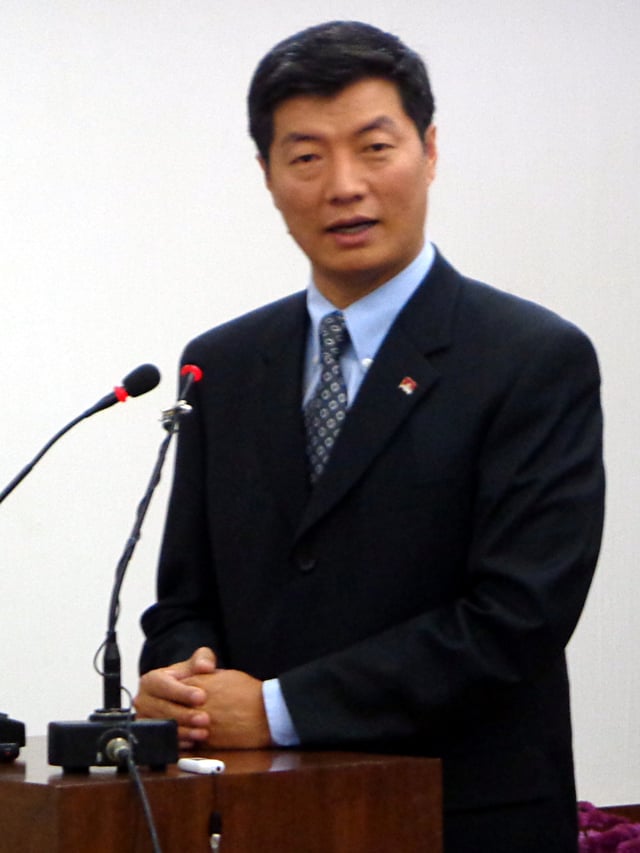
Dr. Lobsang Sangay, Tibetan Prime Minister in Exile
Harvard's prestige and large class size have enabled it to graduate a large number of distinguished alumni.
Rutherford B. Hayes, the 19th president of the United States, graduated from HLS. Additionally, Barack Obama, the 44th president of the United States, graduated from HLS and was president of the Harvard Law Review. His wife, Michelle Obama, is also a graduate of Harvard Law School. Past presidential candidates who are HLS graduates, include Michael Dukakis, Ralph Nader and Mitt Romney. Eight sitting U.S. senators are alumni of HLS: Romney, Ted Cruz, Mike Crapo, Tim Kaine, Jack Reed, Chuck Schumer, Tom Cotton, and Mark Warner.
Other legal and political leaders who attended HLS include former president of the Republic of China (Taiwan), Ma Ying-jeou, and former vice president Annette Lu; current Permanent Judge of the Court of Final Appeal of Hong Kong, and former chief judge of the High Court of Hong Kong and president of the Court of Appeal, Andrew Cheung Kui-nung; former chief justice of the Republic of the Philippines, Renato Corona; chief justice, Sundaresh Menon; former president of the World Bank Group, Robert Zoellick; former United Nations high commissioner for human rights, Navanethem Pillay; the former president of Ireland, Mary Robinson; Lady Arden, Justice of the Supreme Court of the United Kingdom and Solomon Areda Waktolla , Deputy Chief Justice of the Federal Supreme Court of Ethiopia. Deputy Chief Justice Solomon Areda Waktolla is also member of the Court of the Permanent Court of Arbitration .
Lobsang Sangay is the first elected sikyong of the Tibetan Government in Exile. In 2004, he earned a S.J.D. degree from Harvard Law School and was a recipient of the 2004 Yong K. Kim' 95 Prize of excellence for his dissertation "Democracy in Distress: Is Exile Polity a Remedy? A Case Study of Tibet's Government-in-exile".
Sixteen of the school's graduates have served on the Supreme Court of the United States, more than any other law school. Four of the current nine members of the court graduated from HLS: the chief justice, John Roberts; and associate justices Neil Gorsuch, Stephen Breyer and Elena Kagan, who also served as the dean of Harvard Law School from 2003 to 2009. Ruth Bader Ginsburg attended Harvard Law School for two years.[57] Past Supreme Court justices from Harvard Law School include Antonin Scalia, David Souter, Harry Blackmun, William J. Brennan, Louis Brandeis, Felix Frankfurter, Lewis Powell (LLM), and Oliver Wendell Holmes, Jr., among others.
Attorneys general Loretta Lynch, Alberto Gonzales, and Janet Reno, among others, and noted federal judges Richard Posner of the Seventh Circuit Court of Appeals, Michael Boudin of the First Circuit Court of Appeals, Joseph A. Greenaway of the Third Circuit Court of Appeals, Laurence Silberman of the D.C. Circuit Court of Appeals, and Pierre Leval of the Second Circuit Court of Appeals, among many other judicial figures, graduated from the school. The former Commonwealth solicitor general of Australia and current justice of the High Court of Australia, Stephen Gageler, senior counsel graduated from Harvard with an LL.M.[58]
Many HLS alumni are leaders and innovators in the business world. Its graduates include the current senior chairman of Goldman Sachs, Lloyd Blankfein; former chief executive officer of Reddit, Ellen Pao; current chairman of the board and majority owner of National Amusements Sumner Redstone; current president and CEO of TIAA-CREF, Roger W. Ferguson, Jr.; current CEO and chairman of Toys "R" Us, Gerald L. Storch; and former CEO of Delta Air Lines, Gerald Grinstein, among many others.
Legal scholars who graduated from Harvard Law include Payam Akhavan, William P. Alford, Rachel Barkow, Yochai Benkler, Alexander Bickel, Andrew Burrows, Erwin Chemerinsky, Amy Chua, Sujit Choudhry, Robert C. Clark, Hugh Collins, I. Glenn Cohen, Ronald Dworkin, Christopher Edley, Jr., Melvin A. Eisenberg, Susan Estrich, Jody Freeman, Gerald Gunther, Andrew T. Guzman, Louis Henkin, Harold Koh, Richard J. Lazarus, Arthur R. Miller, Gerald L. Neuman, Eric Posner, Richard Posner, John Mark Ramseyer, Jed Rubenfeld, Lewis Sargentich, John Sexton, Jeannie Suk, Kathleen Sullivan, Cass Sunstein, Laurence Tribe, C. Raj Kumar[59] and Tim Wu.
Faculty
William P. Alford
Deborah Anker
Yochai Benkler
Robert C. Clark
I. Glenn Cohen
Susan P. Crawford
Noah Feldman
Roger Fisher
William W. Fisher
Jody Freeman
Charles Fried
Gerald Frug
Nancy Gertner
Mary Ann Glendon
Jack Goldsmith
Lani Guinier
Morton Horwitz
David Kennedy
Duncan Kennedy
Randall Kennedy
Michael Klarman
Richard J. Lazarus
Kenneth W. Mack
John F. Manning
Frank Michelman
Martha Minow
Robert Harris Mnookin
Ashish Nanda
Charles Nesson
Ruth Okediji
Charles Ogletree
John Mark Ramseyer
Mark J. Roe
Lewis Sargentich
Robert Sitkoff
Jeannie Suk
Ronald S. Sullivan Jr.
Cass Sunstein
Laurence Tribe
Mark Tushnet
Rebecca Tushnet
Roberto Unger
Adrian Vermeule
Steven M. Wise
Jonathan Zittrain
Former faculty
Paul M. Bator
Derrick Bell
Derek Bok
Stephen Breyer
Zechariah Chafee
Abram Chayes
Vern Countryman
Archibald Cox
Alan Dershowitz
Christopher Edley, Jr.
Felix Frankfurter
Paul A. Freund
Lon Fuller
John Chipman Gray
Erwin Griswold
Henry M. Hart, Jr.
Oliver Wendell Holmes, Jr.
Elena Kagan
Christopher Columbus Langdell
Daniel Meltzer
Soia Mentschikoff
Arthur R. Miller
Elisabeth Owens
John Palfrey
Roscoe Pound
John Rawls
Joseph Story
Kathleen Sullivan
Joseph H. H. Weiler
Samuel Williston
Buildings gallery
In popular culture
Books
The Paper Chase is a novel set amid a student's first ("One L") year at the school. It was written by John Jay Osborn, Jr., who studied at the school. The book was later turned into a film and a television series (see below).
Scott Turow wrote a memoir of his experience as a first-year law student at Harvard, One L.
Film and television
Several movies and television shows take place at least in part at the school. Most of them have scenes filmed on location at or around Harvard University. They include:
Love Story (1970)
The Paper Chase (1973)
The Paper Chase (1978–1979, 1983–1986 television series)
Soul Man (1986)
The Firm (1993)
A Civil Action (1998)
How High (2001)
Legally Blonde (2001)
Catch Me If You Can (2002)
Love Story in Harvard (2004 Korean TV series)
Suits (TV Series) (2011–Present)
On the Basis of Sex (2018)
Many popular movies and television shows also feature characters introduced as Harvard Law School graduates. The central plot point of the TV series Suits is that one of the main characters did not attend Harvard, but fakes his graduate status in order to practice law.
See also
Ames Moot Court Competition
Harvard Association for Law & Business
Harvard/MIT Cooperative Society, campus bookstore
List of Harvard University people
List of Ivy League law schools
